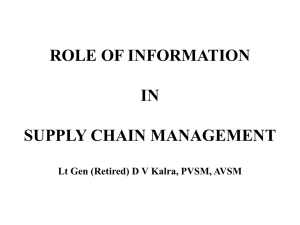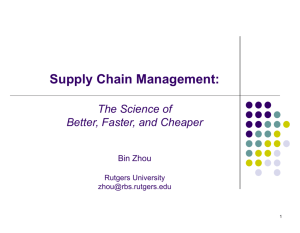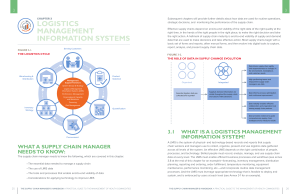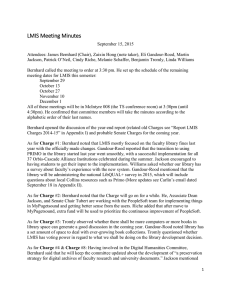Inventory Management
advertisement
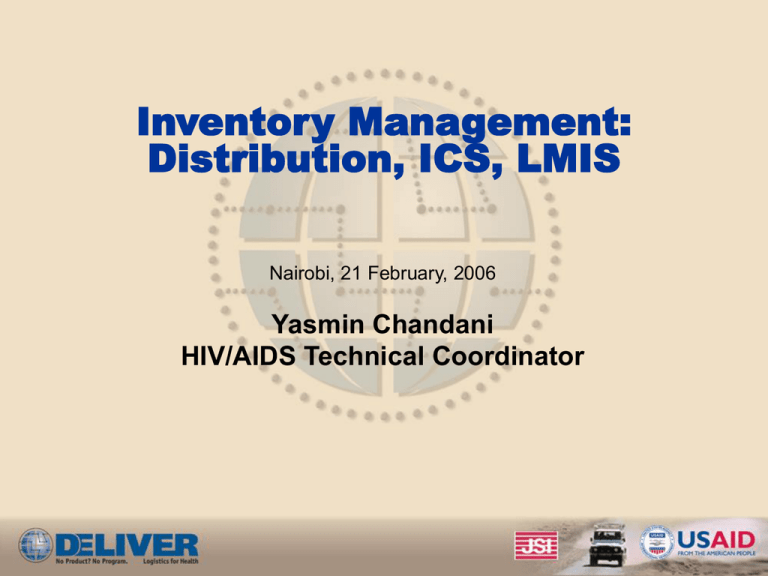
Inventory Management: Distribution, ICS, LMIS Nairobi, 21 February, 2006 Yasmin Chandani HIV/AIDS Technical Coordinator Select Elements of the Logistics System • Distribution – Storage – Transport • Inventory Control Systems • Logistics Management Information System Basic In-Country Supply Pipeline Objectives of Distribution (Storage & Transport) • Storage: Assures product and packaging quality and constant availability • Transport: Assures that products arrive in good condition, in the right place and at the right time The less frequent your re-supply, the greater your storage requirements. Distribution Considerations (Storage & Transport) • • • • Availability of transportation (vehicles) Security during transport Security during storage Sufficient storage space/capacity (based on procurement plan and frequency of deliveries at all levels of the system) • Short shelf life of products • Appropriate storage conditions (cool chain) Distribution Considerations (Storage & Transport) • Which transportation system used? – Pick-up system (facilities collect drugs) or delivery system (warehouses deliver) • Is transportation outsourced? • Do procedures exist to: – Verify the products shipped and received: type and quantity, – Conduct visual inspection for quality assurance, including expiration dates, – Complete and sign transaction records/vouchers, – Store the products, and – Update stockkeeping records Objective of Inventory Control Systems • The objective of an inventory control system is to ensure the constant availability of products, by defining: – When products should be ordered. – What quantities of products should be ordered – How to maintain adequate quantities to meet demand, while avoiding overstocks and stockouts Inventory Control Systems • Maximum/minimum Inventory Control System are defined by months of stock • Systems are designed so stock quantities routinely fall between the minimum and maximum stock levels • The minimum stock level includes safety/buffer stock Any inventory control system (max/min or other) must take into account safety/buffer stock Inventory Control Considerations • Who decides what quantities to distribute? – The lower level (pull) or the upper level (push)? – Decision should be based on training and human resource implications • Which type of max/min system to use? • How long should the pipeline be? – Longer pipeline reduces likelihood of stockouts (more security stock) but increases likelihood of wastage (short shelf lives, increased expiries) • How to include safety stock levels in a nonmax/min system Objective of Logistics Management Information System (LMIS) • The objective of an LMIS is to provide the data and information needed for decision-making at all levels: – Health Center Level: e.g, quantities to order, monitor stock availability – National Level: e.g, quantities to procure, re-supply schedule • The LMIS: – Is a key component of any logistics system, – Impacts ordering, forecasting, procurement – Provides data to facilitate logistics decision-making LMIS Considerations • What data to collect – Only collect data in LMIS that is useful for decision-making in the area of commodity management • Data collection tools – Daily records to capture data – Monthly/quarterly reports – Consistent reports (format, content) – Computerized system or not LMIS Considerations • Regardless of product, always collect the three essential logistics data items: – Consumption – Stock on hand – Losses and adjustments • For other products: – ARV Drugs: number of patients by treatment regimen – HIV Tests: number of tests by purpose of use Common Challenges • • • • Insufficient storage space Inappropriate storage conditions Insufficient transportation resources Different reporting systems in place at same facility (by donor, by program) • No established logistics data collection and reporting systems from SDP to central level • Drug supply is driving prescribing and dispensing • Need for drug storage at home (pediatric formulations) Dynamic Environment • Rapid expansion of programs • Growing experience program strategies and policies continuously evolving • Highly politicized • New technologies for drugs and tests • Decentralized systems • Integrated vs vertical service delivery • Multiple donors/sources of funding


